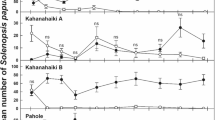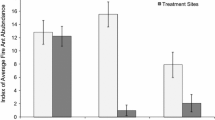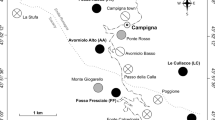Abstract
Many invasive ants, such as the European fire ant (Myrmica rubra), are particularly successful invaders due to their ability to form multi-nest, multi-queen ‘supercolonies’ that appear to displace native invertebrates in invaded regions. Myrmica rubra has invaded many areas in the Northeastern United States, including Western New York. Myrmica rubra invasion corresponds with decreases in native invertebrates, particularly ants, an effect which may be attributable to direct displacement, or because M. rubra prefers habitat unsuitable for native ants. We surveyed Western New York parklands to investigate native ant and non-ant invertebrate abundance in M. rubra-invaded and uninvaded areas. We then tested these observations with an ant pesticide treatment targeting M. rubra to investigate the direct impacts of M. rubra on the native ant and invertebrate community. A consistent, negative relationship was found between M. rubra and native ants in both the observational and experimental research, and native ant species only appeared in the pesticide-treated plots (with reduced M. rubra abundance). These data strongly suggest that M. rubra actively displaces the native ants with invasion instead of segregating by habitat. Myrmica rubra effects on non-ant invertebrates appeared more nuanced, however, in both the observational and experimental research. The absence or removal of M. rubra corresponded with decreased predatory invertebrate populations and increased non-predatory invertebrates. It appears that M. rubra has altered invertebrate communities in Western New York. Native invertebrate communities may be able to rebound with time, but our data suggest native recovery unlikely without management intervention.




Similar content being viewed by others
References
Allen CR, Epperson DM, Garmestani AS (2004) Red imported fire ant impacts on wildlife: a decade of research. Am Midl Nat 152:88–103
Bengston SE, Dornhaus A (2013) Colony size does not predict foraging distance in the ant Temnothorax rugatulus: a puzzle for standard scaling models. Insectes Soc 60:93–96
Bertelsmeier C, Blight O, Courchamp F (2016) Invasions of ants (Hymenoptera: Formicidae) in light of global climate change. Myrmecol News 22:25–42
Boser CL, Hanna C, Faulkner KR et al (2012) Argentine ant management in conservation areas: results of a pilot study. Monogr West N Am Nat 7:518–530
Cassill DL, Tschinkel WR (1996) A duration constant for worker-to-larva trophallaxis in fire ants. Insectes Soc 43:149–166
Cook J (2003) Conservation of biodiversity in an area impacted by the red imported fire ant, Solenopsis invicta (Hymenoptera: Formicidae). Biodivers Conserv 12:187–195
Ellison AM, Gotelli NJ, Farnsworth EJ et al (2012) A field guide to the ants of New England. Yale University Press, New Haven, London
Elmes GW, Petal J (1990) Queen number as an adaptable trait: evidence from wild populations of two red ant species (Genus myrmica). J Anim Ecol 59:675–690
Fox J, Weisberg S (2011) An R companion to applied regression, 2nd edn. Sage, Thousand Oaks
Gaigher R, Samways MJ, Jolliffe KG et al (2012) Precision control of an invasive ant on an ecologically sensitive tropical island: a principle with wide applicability. Ecol Appl 22:1405–1412
Garnas J (2004) European fire ants on Mount Desert Island, Maine: population structure, mechanisms of competition and community impacts of Myrmica rubra L. (Hymenoptera: Formicidae). Ecology and Environmental Sciences, University of Maine, Orono
Garnas JR, Drummond FA, Groden E (2007) Intercolony aggression within and among local populations of the invasive ant, Myrmica rubra (Hymenoptera: Formicidae), in coastal Maine. Environ Entomol 36:105–113
Garnas J, Groden E, Drummond FA (2014) Mechanisms of competitive displacement of native ant fauna by invading Myrmica rubra (Hymenoptera: Formicidae) populations. Environ Entomol 43:1496–1506
Gibb H, Hochuli DF (2003) Colonisation by a dominant ant facilitated by anthropogenic disturbance: effects on ant assemblage composition, biomass, and resource use. Oikos 103:469–478
Gorb SN, Gorb EV (1999) Effects of ant species composition on seed removal in deciduous forest in eastern Europe. Oikos 84:110–118
Gotelli NJ, Arnett AE (2000) Biogeographic effects of red fire ant invasion. Ecol Lett 3:257–261
Groden E, Drummond FA, Garnas J et al (2005) Distribution of an invasive ant, Myrmica rubra (Hymenoptera: Formicidae), in Maine. J Econ Entomol 98:1774–1784
Hanna C, Naughton I, Boser C et al (2015) Testing the effects of ant invasions on non-ant arthropods with high-resolution taxonomic data. Ecol Appl 25:1841–1850
Herbers JM (1986) Nest site limitation and facultative polygyny in the ant Leptothorax longispinosus. Behav Ecol Sociobiol 19:115–122
Hicks BJ, Pilgrim BL, Marshall HD (2014) Origins and genetic composition of the European fire ant (Hymenoptera: Formicidae) in Newfoundland, Canada. Can Entomol 146:457–464
Hobbs RJ, Huenneke LF (1992) Disturbance, diversity, and invasion: implications for conservation. Conserv Biol 6:324–337
Holway DA (1998a) Effect of Argentine ant invasions on ground-dwelling arthropods in northern California riparian woodlands. Oecologia 116:252–258
Holway DA (1998b) Factors governing rate of invasion: a natural experiment using Argentine ants. Oecologia 115:206–212
Holway DA, Suarez AV (2006) Homogenization of ant communities in mediterranean California: the effects of urbanization and invasion. Biol Cons 127:319–326
Holway DA, Lach L, Suarez AV et al (2002) The causes and consequences of ant invasions. Annu Rev Ecol Syst 33:181–233
Human KG, Gordon D (1996) Exploitation and interference competition between the invasive Argentine Ant, Linepithema humile, and native ant species. Oecologia 105:405–412
Kennedy TA (1998) Patterns of an invasion by Argentine ants (Linepithema humile) in a riparian corridor and its effects on ant diversity. Am Midl Nat 140:343–350
King JR, Tschinkel WR (2008) Experimental evidence that human impacts drive fire ant invasions and ecological change. PNAS 105:20339–20343
King JR, Warren RJ, Bradford MA (2013) Social insects dominate eastern US temperate hardwood forest macroinvertebrate communities in warmer regions. PLoS ONE 8:e75843
Krushelnycky P, Gillespie RG (2008) Compositional and functional stability of arthropod communities in the face of ant invasions. Ecol Appl 18:1547–1562
Labatore AC, Spiering DJ, Potts DL et al (2016) Canopy trees in an urban landscape—viable forests or long-lived gardens? Urban Ecosyst 20:393–401
Longino JT (2003) The Crematogaster (Hymenoptera, Formicidae, Myrmicinae) of Costa Rica. Zootaxa 151:1–150
MacDougall AS, Turkington R (2005) Are invasive species the drivers or passengers of change in degraded ecosystems? Ecology 86:42–55
MacDougall AS, Gilbert B, Levine JM (2009) Plant invasions and the niche. J Ecol 97:609–615
McPhee K, Garnas J, Drummond F et al (2012) Homopterans and an invasive red ant, Myrmica rubra (L.), in Maine. Environ Entomol 41:59–71
Menke SB, Holway DA (2006) Abiotic factors control invasion by Argentine ants at the community scale. J Anim Ecol 75:368–376
Michlewicz M, Tryjanowski P (2017) Anthropogenic waste products as preferred nest sites for Myrmica rubra (L.) (Hymenoptera, Formicidae). J Hymenopt Res 57:103–114
Mooney HA, Cleland EE (2001) The evolutionary impact of invasive species. Proc Natl Acad Sci 98:5446–5451
Morris JR, Steigman KL (1993) Effects of polygyne fire ant invasion on native ants of a blackland prairie in Texas. Southwest Nat 38:136–140
Morrison LW (2002) Long-term impacts of an arthropod-community invasion by the imported fire ant, Solenopsis invicta. Ecology 83:2337–2345
Morrison LW, Porter SD (2003) Positive association between densities of the red imported fire ant, Solenopsis invicta (Hymenoptera: Formicidae), and generalized ant and arthropod diversity. Environ Entomol 32:548–554
Naumann K, Higgins RJ (2015) The European fire ant (Hymenoptera: Formicidae) as an invasive species: impact on local ant species and other epigaeic arthropods. Can Entomol 147:592–601
Ness JH, Morales MA, Kenison E et al (2013) Reciprocally beneficial interactions between introduced plants and ants are induced by the presence of a third introduced species. Oikos 122:695–704
Olden JD, Rooney TP (2006) On defining and quantifying biotic homogenization. Glob Ecol Biogeogr 15:113–120
Ouellette GD, Drummond FA, Choate B et al (2010) Ant diversity and distribution in Acadia National Park, Maine. Environ Entomol 39:1447–1456
Parr CL, Gibb H (2009) Competition and the role of dominant ants. In: Lach L, Parr CL, Abbott KL (eds) Ant ecology. Oxford University Press, Oxford, pp 77–96
Pedersen EK, Bedford TL, Grant WE et al (2003) Effect of red imported fire ants on habitat use by Hispid cotton rats (Sigmodon hispidus) and norther pygmy mice (Baiomys taylori). Southwest Nat 48:419–426
Porter SD, Sauvignano DA (1990) Invasion of polygyne fire ants decimates native ants and disrupts arthropod community. Ecology 71:2095–2106
R Core Team Version 3.5.0 (2018) R: a language and environment for statistical computing., 3.5.0 edn. R Foundation for Statistical Computing, Vienna, Austria
Richard F, Fabre A, Dejean A (2001) Predatory behavior in dominant arboreal ant species: the case of Crematogaster sp. (Hymenoptera: Formicidae). J Insect Behav 14:271–282
Rowles AD, Silverman J (2010) Argentine ant invasion associated with loblolly pines in the southeastern United States: minimal impacts but seasonally sustained. Environ Entomol 39:1141–1150
Simberloff D, Martin J, Genovesi P et al (2013) Impacts of biological invasions: what’s what and the way forward. Trends Ecol Evol 28:58–66
Snelling RR, Borowiec ML, Prebus MM (2014) Studies on California ants: a review of the genus Temnothorax (Hymenoptera, Formicidae). ZooKeys 372:27–89
Spiering D (2009) Tifft nature preserve management plan. Buffalo Science Museum, Buffalo, NY
Stuble KL, Kirkman LK, Carroll CR (2009) Patterns of abundance of fire ants and native ants in a native ecosystem. Ecol Entomol 34:520–526
Verble-Pearson R, Pearson S (2016) European fire ant presence decreases native arboreal insect abundance in Acadia National Park, Maine, USA. Nat Areas J 36:162–165
Wardle DA, Peltzer DA (2017) Impacts of invasive biota in forest ecosystems in an aboveground-belowground context. Biol Invasions 19:3301–3316
Warren RJ II, McMillan A, King JR et al (2015) Forest invader replaces predation but not dispersal services by a keystone species. Biol Invasions 23:3153–3162
Warren R II, Reed K, Mathew A et al (2018a) Release from intraspecific competition promotes dominance of a non-native invader. Biol Invasions. https://doi.org/10.1007/s10530-018-1868-z
Warren RJ II, Mathew A, Reed K et al (2018b) Myrmica rubra microhabitat selection and putative ecological impact. Ecol Entomol 44:239–248
Zarnetske PL, Seabloom EW, Hacker SD (2010) Non-target effects of invasive species management: beachgrass, birds, and bulldozers in coastal dunes. Ecosphere 1:1–20
Zavaleta ES, Hobbs RJ, Mooney HA (2001) Viewing invasive species removal in a whole-ecosystem context. Trends Ecol Evol 16:454–459
Acknowledgements
We thank Amy McMillan and Chris Pennuto for comments on early versions of the manuscript. We also thank Dave Spiering, the Tifft Nature Preserve and the New York State Office of Parks, Recreation and Historic Preservation for site access, and we thank Abby Mathew and Kazz Archibald for field assistance and Camille Dorset for laboratory assistance. We also thank two anonymous reviewers for helpful comments on the manuscript.
Author information
Authors and Affiliations
Corresponding author
Ethics declarations
Data accessibility
The data generated and analyzed for the current study are available in the SUNY Buffalo State Digital Commons [https://digitalcommons.buffalostate.edu/biology_data/6/].
Additional information
Publisher's Note
Springer Nature remains neutral with regard to jurisdictional claims in published maps and institutional affiliations.
Rights and permissions
About this article
Cite this article
Goodman, M., Warren II, R.J. Non-native ant invader displaces native ants but facilitates non-predatory invertebrates. Biol Invasions 21, 2713–2722 (2019). https://doi.org/10.1007/s10530-019-02005-w
Received:
Accepted:
Published:
Issue Date:
DOI: https://doi.org/10.1007/s10530-019-02005-w




